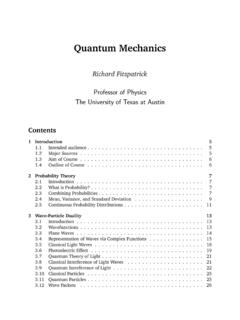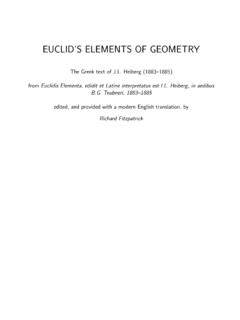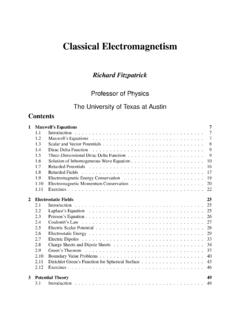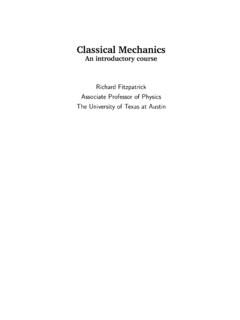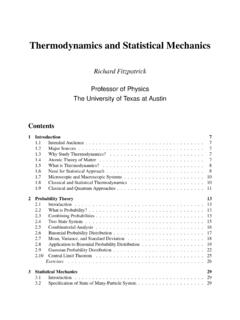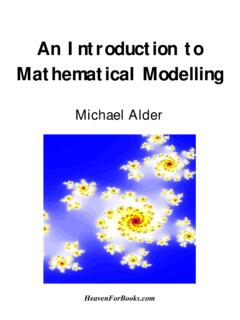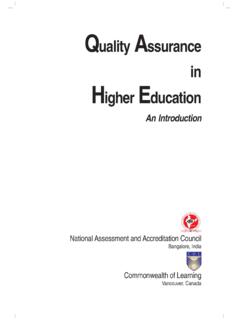Transcription of Classical Mechanics
1 ClassicalMechanicsAnintroductorycourseRi chardFitzpatrickAssociateProfessor ofPhysicsTheUniversity :.. classicalmechanics?.. xes.. cant gures..122 Motionin1 ..263 Motionin3 .. parallelogram..444 Newton' .. 's rstlawofmotion.. 'ssecondlawofmotion.. 'slaw.. 'sthirdlawofmotion.. ,pulleys,andinclines.. elds.. 'slaw.. general1-dimensionalpotential.. rotationa vector?.. pointparticle.. multi-componentsystem.. laminarobjectina gravitational eld.. stretchedstring.. :ThesourceswhichI consultedmostfrequentlywhilstdevelopingt hiscourseare: ,Thirdedition(Holt,Rinehart,& Winston,NewYorkNY, 1977). , , ,Fourthedition, (JohnWiley& Sons,NewYorkNY, 1992).Encyclop diaBrittanica:Fifteenthedition(Encyclop diaBrittanica,ChicagoIL,1994).
2 Physicsfor , , Fifthedition, (SaundersCollegePublishing,OrlandoFL,200 0). classicalmechanics?Classicalmechanicsis thestudyofthemotionofbodies(includingthe specialcaseinwhichbodiesremainatrest)ina ccordancewiththegeneralprinciples rstenunciatedbySirIsaacNewtoninhisPhilos ophiaeNaturalisPrincipiaMath-ematica(168 7),commonlyknownasthePrincipia. Classicalmechanicswasthe rstbranchofPhysicstobediscovered,andis , classicalmechanicshasmanyim-portantappli cationsinotherareasofscience,suchasAstro nomy( , celestialmechanics),Chemistry( , thedynamicsof molecularcollisions),Geology( ,thepropagationofseismicwaves,generatedb yearthquakes,throughtheEarth'scrust),and Engineering( , theequilibriumandstabilityofstructures).
3 Classi-calmechanicsis alsoofgreatsigni ,thesequenceofeventsleadingtothediscover yofclassicalmechanics startingwiththeground-breakingworkofCope rnicus,continuingwiththeresearchesofGali leo,Kepler, andDescartes,andculminatingin classicalmechanics?ofNewton involvedthecompleteoverthrowoftheAristot elianpictureoftheUniverse,whichhadprevio uslyprevailedformorethana millennium,anditsreplacementbya recognizablymodernpictureinwhichhumankin dnolongerplayeda ,including:Translationalmotion motionbywhicha bodyshiftsfromonepointinspacetoanother( , themotionofa bullet redfroma gun).Rotationalmotion motionbywhichanextendedbodychangesorient ation,withrespecttootherbodiesinspace,wi thoutchangingposition( , themotionofa spinningtop).
4 Oscillatory motion motionwhichcontinuallyrepeatsin timewitha xedperiod( , themotionofa pendulumina grandfatherclock).Circular motion motionbywhicha bodyexecutesa circularorbitaboutanother xedbody[ , the(approximate)motionoftheEarthaboutthe Sun].Ofcourse,thesedifferenttypesofmotio ncanbecombined:forinstance,themotionofa properlybowledbowlingballconsistsofa combinationoftrans-lationalandrotational motion,whereaswavepropagationis a , , , thesubdivisionofmechanicswhichis obviouslyofgreatimportanceincivilenginee ring:forinstance,theprinciplesofstaticsw ereusedtodesignthebuildinginwhichthislec tureis takingplace,soastoensurethatit rstprincipleofanyexactscienceismeasureme nt. , ,ormass, length,mass, andtime ,andmostengineers,is calledthemkssystem afterthe rstinitialsofthenamesoftheunitsoflength, mass,andtime,respectively, , themeter, thekilogram, themeter(symbolm),whichwasformerlythedis -tancebetweentwoscratchesona platinum-iridiumalloybarkeptattheInter-n ationalBureauofMetricStandardinS evres,France,butis nowde nedasthedistanceoccupiedby1; 650;763:73wavelengthsof lightof massis thekilogram(symbolkg),whichis de nedasthemassofa platinum-iridiumalloycylinderkeptattheIn ternationalBureauofMetricStandardinS evres, thesecond(symbols),whichwasformerlyde nedintermsoftheEarth'srotation,butis nowde nedasthetimefor9; 192;631.
5 770oscillationsassociatedwiththetransiti onbetweenthetwohyper nelevelsof ,classicalmechanicsalsodealswithderivedq uantities, suchasvelocity, acceleration,momentum, xesmentum, ,mass, ,therefore,thecorrespondingcombinationso fthemksunitsoflength,mass, ,a velocitycanbereducedtoa lengthdividedbya ,themksunitsofvelocityaremeterspersecond :[v] =[L][T]=m s-1:( )Here,vstandsfora velocity,Lfora length,andTfora time,whereastheoperator[ ]representstheunits,ordimensions, masstimesa velocity. Hence,themksunitsofmomentumarekilogram-m eterspersecond:[p] = [M][v] =[M][L][T]=kgm s-1:( )Here,pstandsfora momentum,andMfora , xesmksunitsarespeci , mksunitstendtobecomeratherunwieldywhende alingwithmotionsonverysmallscales( , themotionsofmolecules)orverylargescales( , themotionofstarsintheGalaxy).
6 Inordertohelpcopewiththisproblem,a setofstandardpre xeshasbeendevised,whichallowthemksunitso flength,mass,andtimetobemodi edsoastodealmoreeasilywithverysmallandve rylargequantities:thesepre xesarespeci ,akilometer(km)represents103m,ananometer (nm)represents10-9m,andafemtosecond(fs)r epresents10-15s. Thestandardpre xSymbolFactorPre xSymbol1018exa-E10-1deci-d1015peta-P10-2 centi-c1012tera-T10-3milli-m109giga-G10- 6micro- 106mega-M10-9nano-n103kilo-k10-12pico-p1 02hecto-h10-15femto-f101deka-da10-18atto -aTable1:Standardpre , theobsoletecgs(centimeter-gram-second)sy stemandtheevenmoreobsoletefps(foot-pound -second)systemarestillinusetoday, althoughtheircontinuedem-ploymentis nowstronglydiscouragedinscienceandengine ering(exceptintheUS!)
7 Conversionbetweendifferentsystemsofunits is,inprinciple,perfectlystraightforward, but,inpractice,a frequentsourceoferror. Witness,forex-ample, esthevariousconversionfactorsbetweenmks, cgs, ,ratherconfusingly(unlessyouareanenginee rin theUS!),a poundis a unitof force, (1ft=12in),theyard(1ya=3ft),andthemile(1 mi=5; 280ft).Additionalnon-standardunitsofmass includetheton(intheUS,1ton=2; 000lb;intheUK,1ton=2; 240lb),andthemetricton(1tonne=1; 000kg).Finally, additionalnon-standardunitsoftimeinclude theminute(1min=60s),thehour(1hr=3; 600s),theday(1da=86;400s),andtheyear(1yr =365:26da=31;558;464s). cant gures1 cm=10-2m1 g=10-3kg1 ft=0:3048m1 lb=4:448N1 slug=14:59kgTable2 cant guresInthiscourse,youareexpectedtoperfor mcalculationstoa relativeaccuracyof1% , tothreesigni cant gures.
8 Sinceroundingerrorstendtoaccumulatedurin glengthycalculations,theeasiestwayin whichto achievethisaccuracyis toperformallintermediatecalculationstofo ursigni cant gures, andthentoroundthe nalresultdowntothreesigni cant oneofthequantitiesinyourcalculationturns outtothethesmalldifferencebetweentwomuch largernum-bers,thenyoumayneedtokeepmoret hanfoursigni cant ,youarestronglyurgedtousescienti cnotationinallofyourcalculations:theuseo fnon-scienti cnotationis generallya yourcalculatorsarecapableofoperatingina modeinwhichallnumbers(notjustverysmallor verylargenumbers)aredisplayedinscienti ,length,mass,andtimearethreefundamentall ydifferentquantitieswhicharemeasuredin ,therefore,makesnosensefora prospectivelawofphysicstoexpressanequali tybetween(say)a lengthanda ,theexamplelawm=l;( )wheremis a massandlis a length, ( ) is invalid(asa lawof physics),is to , ifm=linmksunits,thenm6= fpsunits,becausetheconversionfactorswhic hmustbeappliedtotheleft-andright-handsid esdiffer.
9 Physicistsholdverystronglytotheassumptio nthatthelawsofphysicspossessobjectiverea lity: inotherwords, thisassumptionis thata lawofphysicsmusttakethesameforminallposs iblesystemsofunitsthataprospectiveobserv ermightchoosetoemploy. Theonlywayinwhichthiscanbethecaseis if , thequantitiesontheleft-andright-handside softheequalitysigninanygivenlawofphysics musthavethesamedimensions( , thesamecombinationsof length,mass,andtime).A dimensionallyconsistentequationnaturally takesthesameforminallpossiblesystemsofun its, ,letusconsiderwhatis probablythemostfamousequationinphysics:E =m c2:( )Here,Eistheenergyofa body,misitsmass, [M][L2]=[T2], andthedimensionsofvelocityare[L]=[T]. Hence,thedimensionsoftheleft-handsideare [M][L2]=[T2],whereasthedimensionsoftheri ght-handsideare[M] ([L]=[T])2= [M][L2]=[T2].
10 It followsthatEq.( ) ,E=m c2holdsgoodinmksunits,incgsunits,infpsun its, c, orE=m c3, thenhiserrorwouldhavebeenimmediatelyappa renttootherphysicists, ,E=m c2representstheonlysimple,dimensionallyc onsistentwayofcombininganenergy, a mass,andthevelocityoflightina , shouldbenotedthatdimensionalanalysisis offairlylimitedappli-cability, andis a poorsubstituteforanalysisemployingtheact uallawsof physics;nevertheless,it is specialeffectsstudiowantsto lma ,thestudiomightmakea scalemodelofthetower, :TheLeaningTowerof Pisais (say)1 mtall,andthen lmthemodelfallingover. Theonlyproblemis thattheresultingfootagewouldlookcomplete lyunrealistic,becausethemodeltowerwouldf allovertooquickly. Thestudiocouldeasily xthisproblembyslowingthe bywhatfactorshouldthe lmbesloweddowninordertomakeit lookrealistic?
